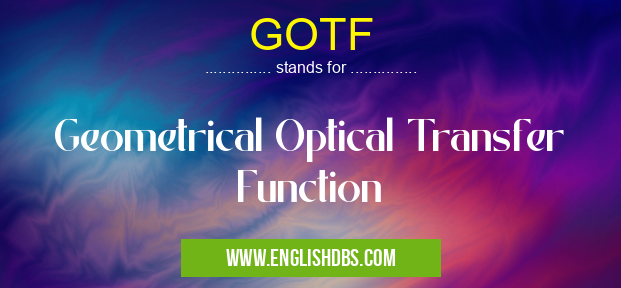What does GOTF mean in UNCLASSIFIED
Geometrical Optical Transfer Function (GOTF) is a mathematical representation of the optical system's ability to transfer spatial information from the object plane to the image plane. It characterizes the system's geometrical distortions, such as magnification, barrel distortion, and pincushion distortion.

GOTF meaning in Unclassified in Miscellaneous
GOTF mostly used in an acronym Unclassified in Category Miscellaneous that means Geometrical Optical Transfer Function
Shorthand: GOTF,
Full Form: Geometrical Optical Transfer Function
For more information of "Geometrical Optical Transfer Function", see the section below.
Introduction to GOTF
GOTF Calculation
GOTF is calculated by tracing a set of rays through the optical system for a given object point. The intersection points of these rays with the image plane form a geometric shape. The shape and size of this shape provide information about the system's geometrical distortions.
GOTF Applications
GOTF is widely used in various applications, including:
- Optical system design: Optimizing optical systems for minimal distortions
- Image processing: Correcting for geometrical distortions in images
- Photogrammetry: Measuring spatial information from images
- Virtual reality: Creating realistic 3D environments
Conclusion
GOTF is an essential metric for characterizing the geometrical performance of optical systems. By understanding the GOTF, engineers and scientists can design and optimize systems for accurate spatial information transfer.
Essential Questions and Answers on Geometrical Optical Transfer Function in "MISCELLANEOUS»UNFILED"
What is Geometrical Optical Transfer Function (GOTF)?
GOTF is a mathematical function that describes the ability of an optical system to transfer spatial information from an object to an image. It measures the system's ability to resolve fine details and the accuracy with which it reproduces the geometry of the object.
Why is GOTF important in optics?
GOTF is crucial in various optical applications, including image processing, optical design, and microscopy. It helps determine the quality of images formed by optical systems and enables the evaluation of lens performance and image restoration techniques.
How is GOTF calculated?
GOTF is calculated using Fourier analysis. It involves transforming the object and image functions into the frequency domain, multiplying them, and then taking the inverse Fourier transform. The result is a function that represents the geometrical distortion and resolution capabilities of the optical system.
What are the different types of GOTFs?
There are two main types of GOTFs:
- Pupil Function GOTF: Describes the transfer of spatial information through the pupil of the optical system.
- Modulation Transfer Function (MTF): A specific type of pupil function GOTF that measures the contrast transfer of the system.
How is GOTF used in practice?
GOTF finds applications in:
- Evaluating lens performance and predicting image quality.
- Designing optical systems to meet specific resolution and distortion requirements.
- Developing image restoration algorithms to correct for optical aberrations.
- Analyzing the effects of atmospheric turbulence on optical systems.
